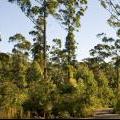The first in our seven part series of how to spot a healthy forest
1. A healthy forest has Balanced Management Practices
 When forests are managed sustainably, there are ecologically sound plans in place for protecting watersheds, harvesting timber, reducing hazards and reforestation. Trees may be thinned to prevent overcrowding, reduce disease, minimise the likliehood of bushfires or enhance access to recreational users. Some management practices are tailored to help conserve habitat for species that would otherwise be lost. The forest may even be burned in a prescribed way to promote growth and prevent higher-intensity natural fires from occurring. Reforestation can be allowed to take place naturally through the growth and spreading of seeds from remaining trees or it can be prompted by new plantings. In a sustainably managed forest, all this activity is carried out by design with a long-term view. On the NSW North Coast, forest compartments (about 200 hectares) are assessed for many values including forest type, cultural heritage considerations, soil and water prescriptions, flora and fauna
When forests are managed sustainably, there are ecologically sound plans in place for protecting watersheds, harvesting timber, reducing hazards and reforestation. Trees may be thinned to prevent overcrowding, reduce disease, minimise the likliehood of bushfires or enhance access to recreational users. Some management practices are tailored to help conserve habitat for species that would otherwise be lost. The forest may even be burned in a prescribed way to promote growth and prevent higher-intensity natural fires from occurring. Reforestation can be allowed to take place naturally through the growth and spreading of seeds from remaining trees or it can be prompted by new plantings. In a sustainably managed forest, all this activity is carried out by design with a long-term view. On the NSW North Coast, forest compartments (about 200 hectares) are assessed for many values including forest type, cultural heritage considerations, soil and water prescriptions, flora and fauna



